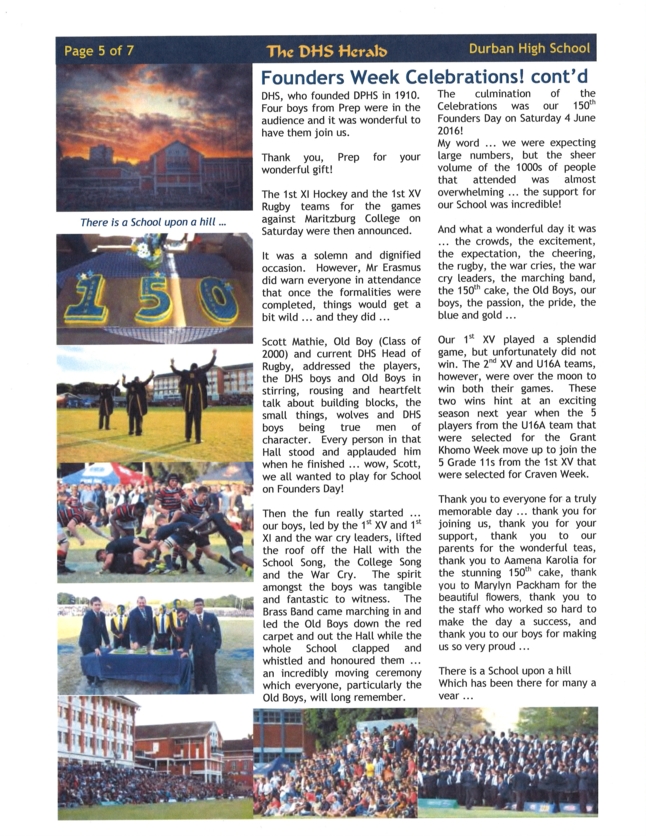
Durban High School![]()
Class Of 1963
| ||||||||||
PROFILE UPDATES
WHERE ARE THEY NOW
WHERE WE LIVE
Who lives where - click links below to find out.
1 lives in Arizona (USA)
3 live in California (USA)
1 lives in Colorado (USA)
1 lives in Connecticut (USA)
2 live in Massachusetts (USA)
1 lives in Pennsylvania (USA)
1 lives in Manitoba (Canada)
1 lives in Ontario (Canada)
6 live in Eastern Cape
14 live in Gauteng
93 live in KwaZulu-Natal
8 live in Western Cape
9 live in USA
2 live in Canada
15 live in Australia
1 lives in Germany
1 lives in Ireland
2 live in Israel
1 lives in Italy
2 live in New Zealand
1 lives in Sweden
16 live in United Kingdom
4 location unknown

|
|
Welcome to the Durban High School Class Of 1963 Website.
The original objective of this website was to locate as many members of our DHS Class of 1963 as possible, and to encourage them to attend the 50th class reunion in Durban in June, 2013. The 50th anniversary reunion was a great success, and was well attended - as the photos elsewhere in this website demonstrate. Since that reunion the website has been used to communicate matters of interest to classmates, for example the amazingly positive improvements at DHS in recent years. The website has also been used to serve the objective of fully funding the Class of 1963 Bursary Fund that was established after the 50th reunion. This fund aimed to create a capital sum sufficient to provide an annual bursary to cover fees for a year as a boarder in Blackmore House for a deserving pupil who might not otherwise have had the opportunity to attend DHS. As is explained in the article that follows below, the fund has already enabled three fine young men to attend DHS.
I never imagined that the website would also be used to communicate information about a 60th Class Reunion! So coordinating that event became an unexpected purpose for which the website was used. As a result a small and successful gathering of Class of 1963 members was held over the Founder's Day weekend at the end of May 2013. Photographs of the classmates who attended the 60th anniversary reunion also appear elsewhere in this website.
After the 60th reunion, and in addition to providing a vehicle for communication between and with classmates, the object of the website became to renew efforts to fully fund the bursary fund. However, it soon became apparent that given the increasing cost of attending the school as a boarder in Blackmores, and with the dwindling number of classmates able to contribute to the bursary fund, the objective of creating a fund capable of funding an annual schorarship was unattainable. So rather than seeking to provide a full annual bursary, the main objective of the website became to secure sufficient funds to provide only a meaningful contribution to enabling a deserving boy attend DHS who might not have been able to but for that contribution. Accordingly, the objective became to create a bursary fund of one million Rands, the major part of the income of which (75%) would be awarded annually as a bursary. As is explained in my email to the class that follows below, that objective was achieved last month.
Sadly, bursary fund trustees Tony Daymond (whose idea the bursary fund was) and Don Allaway did not live to witness the fund reach its million Rand target, Given the loss of two of the three trustees, the succession plan negotiated with the DHS Foundation for the continued management of the fund was implemented, and the bursary fund will henceforth be administaered by the Foundation. But each year the Class of 1963 will be recognised for its creation of the bursary fund.
Classmates are encouraged to continue to use the website to actively maintain contacts with the school and their former classmates. Available methods of maintaining contacts include responding to subjects addressed on the Tuck Shop Chit Chat section of the website, and by keeping classmate profiles up to date so that you can be found by anyone who wants to make contact. Additionally, if anyone knows of the whereabouts of any classmates whose contact information is not available on their profiles, please pass that information on to me at the email address below. Please also use the email address to pass on any other information or questions about the Class of 1963.
Stuart "Mossie" Clark
DHS Class of 1963
January 23, 2025
lgclarx@aol.com
Class of 1963 Bursary Fund Target Reached
I am pleased to announce that the Class of 1963 Bursary Fund has reached its one million Rand target. As a result, active solicitation of donations will now cease. However, the fund will continue to accept bequests and other donations indefinitely.
As classmates will recall, Tony Daymond’s initial objective, conceived at the time of our 50th class anniversary, was to create a fund that would endow an annual bursary to Blackmore House in perpetuity – a fund that Tony calculated would need a capital of about R580,000. However, after a few years it became apparent that, given the limited financial capacity of class members to achieve this objective, and the increased cost of a year in Blackmore House, it was necessary to substitute an alternative objective of offering a more limited bursary that would instead merely assist a deserving boy to attend DHS, rather than providing a full bursary. The alternative objective therefore became to create a fund capital of one million Rands, a target that was achieved last month.
Over the twelve years since the bursary fund was established, the fund has assisted three boys – Matthew Delderfield, Sabelo Malaba, and Kirk Wilson (the 2025 Head Prefect) – who might not otherwise have been able to attend DHS, with partial annual bursaries.
Given the ravages of time, and the deaths of bursary fund trustees Tony Daymond and Don Allaway, the fund has implemented a succession plan agreed uipon with the DHS Foundation to administer the bursary fund in future, and to award an annual bursary of 75% of the fund’s investment income. Assuming a hypothetical interest rate of 7% (about the average rate achieved in 2024), the fund is expected to generate about R70,000 in income a year, for an expected net annual bursary of R52,500. And the undistributed 25% retained in the fund will ensure that the capital of the fund will continue to grow in perpetuity.
Throughout my fundraising efforts on behalf of the fund, I have not identified donors or amounts donated as a matter of privacy and principle. However, given their great generosity in chipping in to donate the R120,000 shortfall that was needed to push the fund over the million Rand mark, I have decided to identify the five US based classmates who made this possible. They are Peter deVilliers (1963 Head Prefect, Rhodes Scholar, and professor emeritus at Smith College, Northampton, Massachusetts); Brian Christie (formerly a corporate attorney in Newport Beach, California, and now retired in Williamsburg, Virginia); Joe Wolfsdorf (Professor of Pediatrics, Harvard Medical School, Boston, Massachusetts); Malcolm Hilcove (business owner and serial entrepreneur, of Phoenix, Arizona); and Stuart Clark (semi-retired attorney in San Diego County, California). Thank you guys for providing the wherewithal to reach the fund’s target.
Special thanks for the achievement of the target are also due to Tony Daymond and Don Allaway, who contributed to that result by money donations and donations of sweat equity. From the outset of his suggesting the creation of a bursary fund to his untimely death, Tony was the liaison between the bursary fund trustees and DHS and the DHS Foundation. His supervising the management of the bursary funds, the selection of bursary holders and liaison with them – and the myriad of matters that needed someone “on the ground” to interact physically with the school when required - were critical to the success of the project. Don also worked tirelessly with the trustees of the DHS Foundation (of which he was a trustee for a time) to protect the interests of the bursary fund and to negotiate the terms on which the Foundation would take over the management of the bursary fund. And Don was also instrumental in soliciting a substantial donation to the bursary fund from another trust of which he was also a trustee.
Thanks are also due to Andrew “Shedders” Shedlock, the CEO of the DHS Foundation, for his support and encouragement of the bursary fund trustees’ efforts. He made himself available to Tony and the other trustees whenever needed, and ensured a friendly and professional relationship between the bursary fund trustees and the school and DHS Foundation.
Last but not least, thanks are due to the many other classmates who made donations to the bursary fund that caused the fund to have enough money so that the US based classmates merely had to top up their contributions by finding another R120,000. Thanks to all classmates who contributed to the fund for your wonderful support!
Our class of 1963 can be proud of what has been accomplished, and what will be accomplished in future, by the Class of 1963 Bursary Fund. Accomplishments that will be recognised each year by the announcing of the awarding of the bursary to a deserving boy at a school assembly. So classmates, you can pat yourselves on your backs for a valuable contribution to DHS and the DHS community!
May 2025 be a happy and healthy year for all of you!
Kind regards,
Stuart “Mossie” Clark
January 10, 2025
1-650-714-3284
Class of 1963 60th Anniversary Reunion
The Class of 1963 held a small but very successful 60th anniversary reunion of our matriculation over the DHS Founders’ Day weekend at the end of May. Disappointingly only thirteen class members attended, with some wives. Attendees were Don Allaway, Chris Allen, Sean Baker, Nick Bryant, Joe Brown, Stuart Clark, Tony Daymond, Arthur Godbeer, Malcolm Hilcove, Ian Jackson, Thorvald Krige, Sheldon Jones, and Dave Karon.
The celebrations started with the golf tournament on Thursday at the Royal Durban Golf Course for all classes celebrating special dates. Our golfers were Don Allaway, Sheldon Jones, Dave Karon, and Stuart Clark – with Malcolm Hilcove retired hurt!
On Friday the celebrations continued with class members attending a regular assembly of the entire school, at which – among other things – the first rugby and hockey teams were introduced. A highlight of the assembly was the rousing rendition by the boys of the school fight song/war cry. It was an incredibly emotional performance, and yet another example of how successfully DHS has adapted to and embraced the new South Africa.
Following the assembly our class members were honoured to be offered the new Memorial Pavilion as the venue for our anniversary lunch – which was the main event of our class celebrations. Headmaster Tony Pinheiro addressed the attendees, describing the amazing variety of educational and other opportunities now offered by the school, and the addition of recent improvements to the physical amenities of the school, including the Astroturf hockey field and fitness centre. DHS Foundation CEO Andrew Shedlock also addressed the class, describing the support for the school provided by the foundation.
On Saturday some class members watched the first hockey teams of DHS and Kearsney playing on the Astroturf; DHS won 4-1. Then followed arguably the most important event of the entire celebration, namely the 1st XV rugby teams of DHS and Kearsney. After a shaky start DHS won 47-23. An excellent and spirited performance by a highly motivated team! Once again, our class members were honoured to be permitted to use the Memorial Pavilion.
The atmosphere at the school on the Saturday of Founder's Day was electric. Rugby matches were played on both fields, and various hockey games were played on the top field, so the school was teeming with players. And also with supporters. Boerewors was being braaied both on the fringe of the rugby field and in the Memorial Courtyard, where those present were able to watch the match on a big screen TV. The enthusiasm was palpable throughout the school campus.
All in all the class members who attended left the school convinced that DHS is in good hands, and that it is well equipped to turn out young men who will do their school and their country proud. Those of our class who heard Stephen Saad’s speech at the dinner at our 50th anniversary, making suggestions about how the school might be elevated from good to great, will be comforted to know that under Mr. Pinheiro and his staff DHS has met Stephen’s challenge – and then some!
Stuart Clark
DHS Class of 1963
June 30, 2023
Tony Daymond, Sheldon Jones, Dave Karon, Joe Brown, Don Allaway, Malcolm Hilcove, Thorvald Krige, Ian Jackson (crouching), Stuart Clark, Chris Allen, Arthur Godbeer, Nick Bryant, Sean Baker, and headmaster Tony Pinheiro
Class of 1963 Bursary Fund
Following the 2013 reunion Tony Daymond suggested that the class should create a bursary fund to sponsor a deserving young man who would not otherwise be able to attend DHS to do so. At the time it was envisaged that a fund of R580,000 would be sufficient to provide a bursary in perpetuity to attend DHS as a boarder. The hope was that if 100 classmates contributed R5,800 to the fund – as a lump sun or over time – the objective of providing a bursary in perpetuity would be accomplished.
The initial response to the request for donations was very encouraging, but it took a lot longer than we expected for what became the Class of 1963 Bursary Fund to accumulate a R580,000 fund (in fact that target was only reached in 2022!). And in hindsight the contemplated fund turned out to woefully inadequate. Nevertheless, partial bursaries were awarded that enabled three accomplished and deserving young men to attend DHS. These are the young men whose photographs appear below (Kirk is the current bursary holder).
|
|
|
|
|
Mathew Delderfield |
Sabelo Mlaba |
Kirk Wilson |
Since the initial target for the fund was set almost ten years ago, things have changed drastically. Specifically school fees have increased significantly, and the return on the invested funds (which are managed by the DHS Foundation for the Class of 1963 Bursary Fund) have diminished. The result is that the principal required to fund a boarder’s bursary in perpetuity has grown exponentially, to between R1.2 million to $1.5 million – while the investment return on the fund has diminished.
The trustees of the Class of 1963 Bursary Fund are intent on carrying out an energetic effort in 2023 – as part of the 60th anniversary of our matriculation – to enlarge the fund to provide for an annual bursary. Recognising that this will be a tall order absent some large contributions, the trustees’ backup plan is that the bursary fund will continue providing partial bursaries up to the amount of the earnings on the principal. This will preserve the principal to assist future deserving boys who wish to attend DHS, while continuing to recognise the contributions of the Class of 1963 to sponsoring boys to DHS.
Anyone who is able to assist the Class of 1963 in their efforts by contributing to the fund should please contact the DHS Foundation, through the school or its website at https://www.dhsfoundation.co.za/, or by emailing Stuart Clark at lgclarx@aol.com.
Stuart Clark
December 26, 2022
* * *
VISIT TO DHS 2020
Brian Christie sent me the following description of his recent trip to DHS. As you will discover, it makes interesting reading.
For about three weeks at the end of January and beginning of February of this year I travelled to South Africa. The primary reason for my trip was to check up on my sisters and their families.
I spent three days with Mike Keggie (my best friend at DHS) and his wife in Cape Town. Mike is a retired Anglican minister – but is still very active preaching and pastoring. The highlight was to watch a One Day International at Newlands in which South Africa beat England.
I then flew to Joburg and spent five days with Don Allaway, and enjoyed his and his wife’s generous hospitality. A highlight there was a golf outing at the Country Club of Johannesburg with Don and two other DHS Old Boys, Roy Henry and Andrew Crawford, who is the Finance Chairman of the DHS Foundation. I happened to be there in the middle of the Glenwood rugby “poaching” issue, so that was a big subject of discussion since the DHS Foundation had paid for the 4 boys to go to Glenwood Prep with the agreement that they would come to DHS for high school. Those of you in South Africa are no doubt still following the saga.
Don and I also met with Sizwe Nxedlana, the Chairman of the DHS Foundation (1999 matriculant, and now CEO of FNB Wealth & Investment and CEO of Ashburton Investments) and Damian Judge, Vice Chairman of the DHS Foundation (2001 matriculant, and CFO of Trellidor), two outstanding young Old Boys in their thirties, who are key members of the DHS Foundation Board. Both are positive about the improvements and direction of DHS under the new headmaster, and optimistic about the future of South Africa.
At the request of the Foundation, my law firm, on a pro bono basis, formed a non-profit California corporation – what we call a 501(c)(3) corporation – which, after much back and forth, has been approved by the US Internal Revenue Service. So Americans can now make donations to our non-profit corporation (called Impact DHS) and get a tax deduction. What this means is that if a US taxpayer is in the 35% tax bracket and makes a $1,000 contribution to Impact DHS he gets to deduct the $1,000 from his taxable gross income. So, the $1,000 contribution only really costs him $650. But the $1,000 converted to Rand is R18,000 (at today conversion rate). That means that his $650 real cost is “converted” into R18,000 – a 27 times return. A huge impact!
The DHS Foundation is hopeful that Impact DHS will provide a source of funds to provide scholarships and bursaries to needy boys as well as for general operation purposes. All of this made me a minor celebrity when I went to DHS for the day. Tony Daymond picked me up at the airport and was my host for the day. He drove me to DHS where we met with Tony Pinheiro, the headmaster, Andrew Shedlock, the CEO of the DHS Foundation, and various teachers who came by to introduce themselves. Tony spent a good deal of time with us explaining the positive steps he has taken to improve the overall learning experience for the students. He gets good reviews from all I talked to. He explained to us the new A-level “Cambridge” matric program which enables students who matriculate under this option to attend university anywhere in the world.
I was given a tour of the school and spent some time in the A-level area. I talked to six boys in that area (two blacks, three Indians and one white) for about 20 minutes. I wanted to make sure that what the headmaster was telling me was actually happening in the classroom. They were really positive about the program. Rather than lectures being the primary teaching format, self-study in groups is emphasized. For instance, instead of a lecture on the Vietnam war, three or four students are assigned the Vietnam war to study for a week or so, and then make a presentation to the class. The three teachers I talked to were really positive about the program. Teaching motivated students is always stimulating. I even gave a short pep talk to one of the A-level classes studying Geography. Grayson Heath’s daughter is heading up the A-level program and is highly esteemed for her vision, enthusiasm and commitment.
To be honest, the boys I talked to (more than just the six I mentioned above) were all much more engaged and enthusiastic about their classes that I was when I was at DHS. I thought you went to school to play rugby, cricket, hockey and athletics, and that schoolwork was something to be endured to get to the after-school sports activities! But even half-focused boys like me received a really solid high school education that has stood us in good stead, and been the foundation for our university education and careers. In fact, our DHS high school education in the 1960s was in many ways superior to the high school education my three sons received here in the US.
The boys that I met at DHS are the future of South Africa. If we can help them get the same education we received then South Africa has a bright future – in spite of the obvious challenges they face.
Brian Christie
DHS Class of 1963
April, 2020
Headmaster Tony Pinhero, Brian Christie, and DHS Class of 1963
Bursary Recipient Sabelo Mlaba
* * *
THE OLD SCHOOL BUILDING – A DESCRIPTION
The classic and gracious – but in the 1960s somewhat dilapidated - old school building, which was erected in 1894, was primarily used for the boarding establishment. The building was demolished in the late 1960s, and replaced by the existing building. How the Old Boys and other interested parties allowed the building to be demolished – rather than at least retaining the front section of the building, and erecting a new building behind it – boggles my mind. But when this all happened I was enjoying the good life as a Natal University student – had the demolition occurred when I was at a more mature age I might have tried to marshal some Old Boys to fight the demolition.
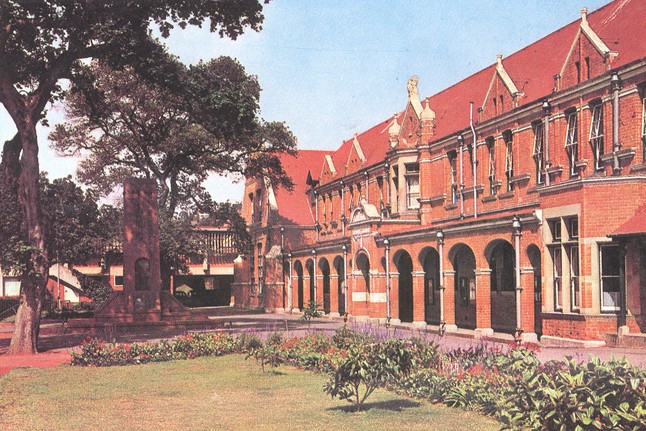
The Old School Building In The 1960s
The main entrance of the boarding establishment was in the centre of the covered verandah that ran the length of the façade, and was decorated with an attractive gable. Immediately on entering the building there was a short passage, with an exit door from the prefects’ room on the left, and a blank wall with notice boards on the right. At the end of that short passage there was a two storey entrance lobby, with a corridor to the left and another to the right. The left corridor led to the library, past the entrance door to the prefects’ room on the left. The corridor then proceeded past the entrance door to a classroom/utility room also on the left, and opposite that a door on the right leading to the quadrangle; and then at the end of the corridor were the double doors of the library entrance (which room may well have initially been the school hall).
To the right from the entrance lobby the passage led to the boarder’s dining room, past a door to the left also accessing the quadrangle, through double doors at the end of the passage into the dining room.
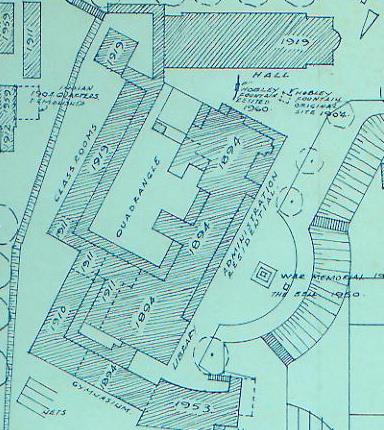
Plan of the Old School Building, With Dates of Construction
The dining room was a large rectangular room laid out rather like the depiction of such a facility in the Harry Potter films. On the St. Thomas Road end of the dining room was a raised platform with a long table at which the boarder masters sat facing towards the boarders. In front of the masters, and parallel with the façade of the school, were two long tables next to each other running the length of the room. Third formers sat at the table nearest to the front of the building, with Fourth and Fifth formers at the next table, and the matrics and prefects at two smaller tables located parallel to the long tables on the quadrangle side of the room.
Back to the lobby, on the quadrangle side there was a staircase that ascended along the right hand side wall, onto an intermediate landing along the rear wall, and then ascending along the left hand side wall, to a second floor corridor which ran the length of the building, parallel to the façade.
Behind the back wall of the lobby downstairs was the “Boot Room”, where the boarders kept their shoes in open cubicles in shelves around the walls (the room was also used as a private place to rub your bum after being flogged!).
At the top of the stairs from the ground floor of the lobby was the boarder master’s lounge, with its bay window, above which was an attractive exterior gable. On each side of the lounge were two master’s rooms. Off the corridor running the length of the building upstairs, on the St. Thomas Road side of the second master’s room, was the “Middle 1” dormitory for Fourth Formers, which overlooked the sports fields. Continuing in that direction the corridor led to the matron’s quarters, which were accessed from the corridor and by an entrance near the headmaster’s office downstairs on the first floor. In the opposite direction the corridor led past the “Middle 2” Fifth Form dormitory on the left, then past a door on the right leading to the balcony dormitories, then to the “Top Left” Fifth Form dormitory on the left and the “Top Right” matric dormitory on the right, and finally to the head prefect’s room between the latter two dormitories (The Top Left and Top Right dormitories were directly above the library.)
On exiting the corridor through the door opposite Middle 2, to the balcony dormitories, one passed the Fourth Form “Verandah 1” dormitory on the left, and then also the Third Form “Verandah 2” dormitory on the left, on the Windmill Road side of the quadrangle. After the Verandah 2 dormitory, in the corner of the building, was the room of the head boarder master – “Charlie” Crewe in the 1960s. The corridor then took a right turn, with a stairway down to the 3rd Form bathroom. Following the right turn, next came the “Verandah 3” and “Verandah 4” Third Form dormitories, on the Vause Road side of the quadrangle. At the end of the balcony was the Sixth Form bathroom. Next to the bathroom was an external stairway down to the quadrangle.
On the ground floor the quadrangle had a covered verandah around its Windmill Road and Vause Road perimeter, with classrooms on the two sides underneath the Verandah 1 through 4 dormitories. On the Windmill Road side there was a large room that was – I think – known as the “boarder’s library, which the 4th and 5th Form boarders used as the room in which they did prep (i.e. their homework). Beyond the boarder’s library was a corridor to the left, which ran parallel to Vause Road and had two or three classrooms. The corridor then made a left turn, parallel to Windmill Road, and opening up under a verandah, with three or four classrooms to the right. Two of those classrooms were later turned into a gymnasium. On the Vause Road side of the quadrangle, in the part of the building shown in the background of the Blackmore’s house photograph of 1963 which is reproduced below, were two more classrooms. In addition to the classrooms, the third form bathroom was in the corner (to the left of the photo), and the 4th and 5th Form bathrooms were on the right of the photo.
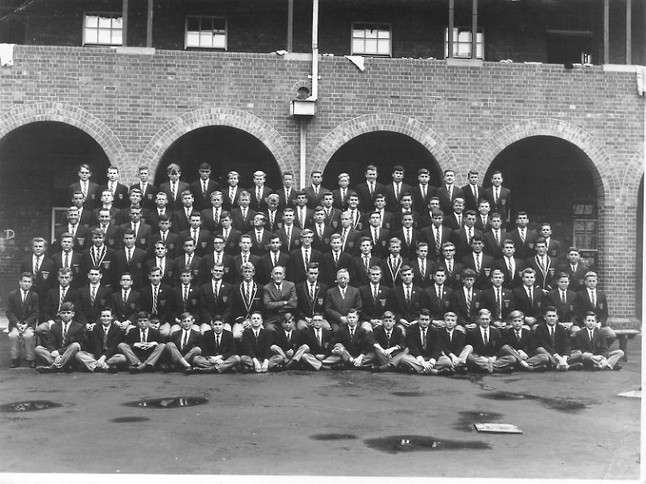
Blackmore’s House 1963: Vause Road Side Of The Quadrangle In The
Background, With Verandah 3 and 4 Dormitories Upstairs, and Head Boarder Master Charlie Crewe and Headmaster A. W. McIver in the Front Row
The quadrangle was used for boarders’ assemblies before breakfast (at 7.15 a.m.) and before dinner (at 6.00 p.m.) each day. The boarders would line up under the verandah surrounding the quadrangle, with the 6th Formers against the side wall of the boot room (unless it was raining), the 5th Formers starting adjacent to the passage past the entrance to the prefects’ room, and proceeding along the Windmill Road side of the quadrangle, followed by the 4th and 3rd Formers until about as far as behind the house photo, above.
On the portion of the verandah of the quadrangle on the other side of the boot room, and adjacent the corridor leading to the dining room, was a large table with benches on each side which was used by the cadets – and primarily the school band – to “bone” their boots and whiten their putties and belts and polish their instruments.
The section of the boarding establishment comprising the Verandah 1 through 4 dormitories and the classrooms and other facilities below were not part of the building erected in 1894 – they were added in 1919. The classrooms down the passage that ran from the middle of the Windmill Road side of quadrangle were added in 1910 and 1911.
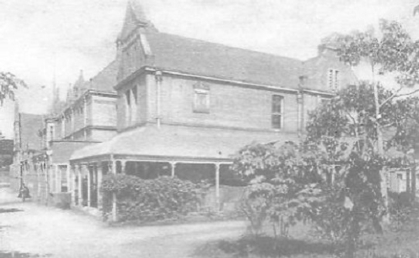
An Early Photograph of The St. Thomas Road End Of The Old School Building
On the Thomas Road side of the building – pictured above – the ground floor comprised the headmaster’s office (on the corner), and the deputy headmaster’s office – and, I think, a sitting room for visitors. On the Vause Road side of the headmaster’s office was the school secretary’s office and administrative offices, and next to that the sick room.
On the first floor above the facilities described in the previous paragraph was the flat of the matron of the boarding establishment.
Finally, on the ground floor off the St. Thomas Road side of the quadrangle, and on the Windmill Road side of the administrative offices, was the kitchen of the boarding establishment.
As will be apparent from the above description, when built the old school building included all the facilities needed to accommodate a school with the characteristics of an English public school. And with an elegant building of the kind that one would expect in a growing country within the British Empire!
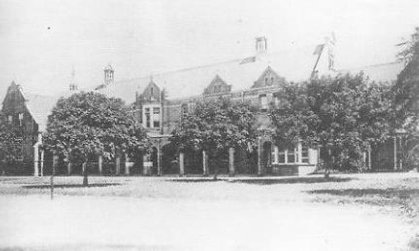
An Early Photograph of The Old School Building Before Terracing
Finally, the above photo shows the school in its early days – long before the terracing, which may have been added in the early 1950s when the swimming pool was built.
Stuart “Mossie” Clark
July, 2019
* * *
October 2017 Visit to DHS
Late last year I visited DHS to meet Louis Arde’, the new CEO of the DHS Foundation. I was met at the school by our classmate Howard Buttery, who introduced me to Louis. While at the school I also caught up with another classmate – Jerry Oddy, who is now the School historian.
Jerry gave me a tour of the school, and I was very much impressed indeed with what I saw. What first impressed me was the courtesy of the boys. Almost every boy with whom I made eye contact as we walked the corridors politely said “good morning.” And all of them were neatly dressed in their full school uniforms. Also impressive were the facilities – especially the media centre (the modern equivalent of what we knew as a library), the Seabrooke Theatre (where I dropped in on an impromptu series of skits), and the Victor Daitz Mathematics and Science Center.
Those of you who attended the Founder’s Day dinner in the year of our class 50th anniversary will remember the impassioned plea of after dinner speaker Stephen Saad for Old Boys to financially support the school by contributing to the DHS Foundation – even by small monthly contributions. Steve bemoaned the decline in the school’s academic and sporting performance, and reputation, to the extent that Old Boys were sending their sons to schools other than DHS.
The mission of the Trust, in the words of its website is:
to provide additional financial support for capital development of the school in order to ensure that fees do not become prohibitively expensive and, secondly, to provide scholarships, be they full or part, for students who are unable to meet the financial demands of an education at DHS but who have exceptional merit in academics, sport or cultural pursuits and would be an asset to the school.
I have not lived in Durban for many years, so I was out of touch with the extent of competitive bidding between high schools for the best students – especially, apparently, those who play rugby! The bait is typically bursaries and other financial sponsorship incentives – an arena in which DHS was not competing five years ago.
In the five years since Steve’s speech, DHS has made remarkable strides. The school facilities have been improved by the refurbishment of Blackmores, the creation of the media centre and theatre and science and mathematics facilities referred to above, and the general refurbishment of the physical assets of the school. The school’s academic offerings and results have also continued to improve to reach the highest level. And, last but not least, the performance of the school’s teams has greatly improved too – last year the 1st XV beat Glenwood for the first time in years! (However, there is still much room for improvement, as today I saw the results of the weekend cricket matches against Westville!)
Louis and Howard brought me up to date on the activities of the Foundation, and especially its aggressive efforts to provide funding for scholarships that can be offered to attract the best boys to attend the school. As of the time of my visit there were 53 fully funded bursaries available, and the target is to have at least 150 within three years – of which the Foundation has agreed to provide 30. Our Class of 1963 Bursary Fund is making its own small contribution to the Foundation’s efforts, by partially sponsoring a scholarship for boarder Matthew Delderfield (while hoping to eventually create a sufficient principal amount in the bursary fund to provide a full bursary).
The bottom line – based on my morning at the school – is that DHS is well on its way back, and is fulfilling a key role in producing young men who will make a positive contribution to their communities and society. Have a look at the recent video released by the school as part of its marketing efforts, at https://www.youtube.com/watch?v=tUEDdQHTCRQ&feature=youtu.be (note the return of the basher!).
If you have not yet contributed to the Class of 1963 Bursary Fund – of if you have already done and want to top up your contribution – please consider supporting your old school and its mission by making a contribution now. Bank transfer details can be found on the Class of 1963 Bursary Fund page of the website www.durbanhighschoolclassof1963.com. Otherwise, please email me at lgclarx@aol.com and I’ll provide whatever information you need to make your contribution.
Stuart “Mossie” Clark
February 20, 2018
* * *
Report on DHS 150th Anniversary Events
Perhaps the best way to report on the 150th Anniversary events is to reprint the June 10, 2016 DHS Herald, which appears below:
If you do not recive the DHS Herald, but would like to, please send an email to editor@durbanhighschool.co.za, and ask to be added to the emailing list.
Best regards,
Stuart “Mossie” Clark
Posted June 15, 2016
* * *
Class of 1963 Bursary Fund Established
On August 13, 2013 the DHS Class of 1963 Committee announced the establishment of a Class of 1963 Bursary Fund, to sponsor the attendance of a deserving pupil at DHS. The objective is to raise a capital amount of R585,000 to fund this bursary, which it is hoped will be awarded for the first time for attendance at the School in 2017.
The R585,000 represents a R150 contribution per month for the 39 months between October, 2013 and December 2016, by an estimated 100 class members (or the lump sum equivalent). However contributions of any amount will be welcomed - class members are encouraged to contribute according to their ability and inclinations.
For further information about the bursary fund, and how to contribute, please click on the "Class of 1963 Bursary Fund" page of this website.
Thanks in anticipation for your interest and support!
* * *
Even though the reunion has come and gone, please complete your profile in the Classmate Profiles section of the website if you have not already done so.
If you have not already done so, please complete your profile on the website - preferably including a summary of what you have been up to in the past 50 years, and by adding a current photograph.
Also please advise me if you know of the whereabouts of anyone on the classmates list who has not signed up - or give them the website address and suggest that they should sign up. We need to track down as many class members as possible!
With kind regards to all my classmates of so many years ago,
Stuart “Mossie” Clark
Websites For Other Class Years
There are other class websites for the following DHS class years – if you are a member of any of those classes, contact the website administrator to activate your profile:
1960 – http://www.dhs-class-of-1960.net/ - macornelissen@shaw.ca (Michael Cornelissen)
1961 - http://www.dhs-class-of-1961.net/ - drianrobertson@gmail.com (Ian Robertson)
1963 - http://www.durbanhighschoolclassof1963.com/ - lgclarx@aol.com (Stuart Clark)
1964 - http://www.dhsclassof1964.com/ - gabbybell@gmail.com (Graham Bell)
1965 - http://www.dhsclassof65.net/ - terry.sandy @chep.com (Terry Sandy)
1966 - http://www.dhs-class-of-1966.com/ - cedric @cornerstonec.co.za (Cedric Parker)
1988 – website in the course of construction - contact Andrew Stringer at ganginoz @gmail.com
Other Websites Of Interest
Durban High School - www.durbanhighschool.co.za/
DHS Foundation - http://www.dhsfoundation.co.za/
Powered by Class Creator

.jpg)
.jpg)
(1).jpg)
.jpg)
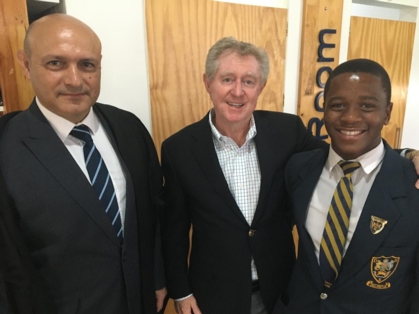
.JPG)
.JPG)

.JPG)
